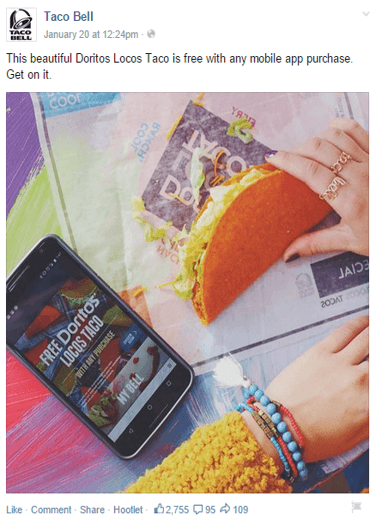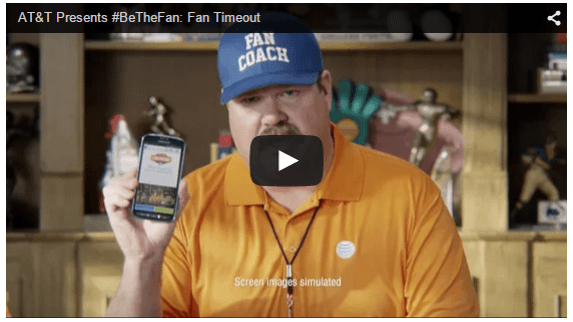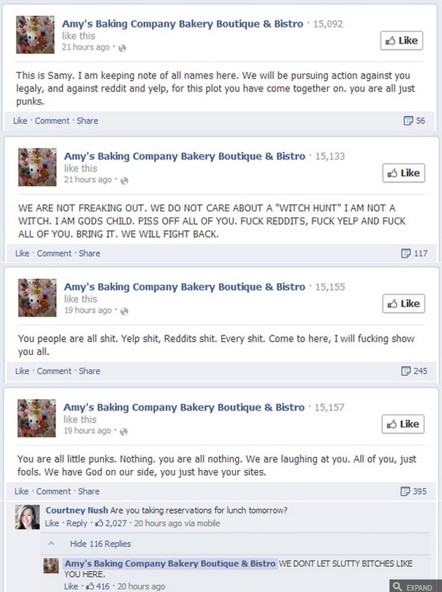It’s no secret that marketers are relying on social media as a significant part of their marketing strategy.
In fact, according to Social Media Examiner, an astounding 92% of marketers have indicated that social media is important for their business in 2014.
That was up from 86% of marketers during the same study conducted in 2013.
So how are big brands making the most of social media?
We’re going to answer that question by exploring a number of case studies showing how brands identify buyer personas, create unique social media campaigns, and handle customer service issues.
Editor’s Note: To learn more on how to create a social media strategy for multiple clients, check out Debbie Miller’s Marketing Nerds episode.
 Image Source: Pixabay
Image Source: PixabayHow to Identify Your Buyer Persona
According to the Buyer Persona Manifesto, a buyer persona is “an archetype, a composite picture of the real people who buy, or might buy, products like the ones you sell”. In other words, they are your ideal customer.
Why do we need to understand these personas? There are several reasons why clearly defined online buyer personas are important for brands:
- They provide a greater understanding of who they are and what their wants or needs are.
- They can help improve your content and ad messages so they’re even more powerful.
- Allow you to obtain better insights into your customer’s actions, which then can be used to fine tune campaigns.
Tools For Identifying Personas
- MakeMyPersona.com: This tool is powered by HubSpot, which easily generates a document of your buyer persona after completing the step-by-by guide wizard.
- UpCloseandPersona.com: B2B marketing strategist Ardath Albee developed this free buyer persona tool, which also includes resources and helpful tips.
- UsersBox.com: Usersbox claims to be “the first persona profiling service aimed to assist you in getting to know your target audience.” With this knowledge, you can focus on the parts of your product or service that your audience would enjoy the most.
- Seeker.com/target/personas: This tool can help you discover everything from demographics to consumer interests to which devices they frequently use so you can effectively target your particular audience.
- Google Analytics: Using user behavior metrics like geography, device, and if enabled, Google’s own demographic data, you can build personas of your existing audience.
Case Study: Four Seasons
After noticing that third-party sites like Priceline and Kayak were capitalizing on discounted room rates, which included some of the 92 global hotels and resorts that the Four Seasons operates, the company decided to create their own mobile app.
In order to compete with third-party apps, the Four Seasons wanted an app that would engage new and existing customers by letting them view and book various vacation destinations. So, they created buyer personas that reflect who their various customers may be.
One example would be Mark, a 40 year-old senior consultant in Manhattan, who is looking to book a family trip with his wife and five-year-old son. Mark would pull up the Four Seasons app and search for family friendly vacations. He might book a trip to Maui after noticing that the hotel advertises an itinerary tailored to children.
Another scenario would be Sarah, a 32 year-old project manager for a Bay Area technology company. She downloads the Four Seasons app after one of her friends shows her all of the amazing pictures from a recent trip to Paris. Before going to bed, Sarah decides to plan her next vacation and shares her favorite hotel pages with her boyfriend with the share feature.
The team behind the Four Seasons app started by creating photo prototypes of buyer personas with the idea of creating a “mobile concierge”. The sketches were imported to an app called PopApp so a working prototype could be created for testing. With an emphasis on usability and core functions, the browser was created so that visitors could easily browse and book vacations on any device. The team went one step further and created a visual mockup.
Case Study: Taco Bell
 Taco Bell has earned a reputation of being a socially-savvy brand able to effectively target the millennial audience. One way in which Taco Bell optimizes this is by utilizing Snapchat, an app widely preferred by younger individuals.
Taco Bell has earned a reputation of being a socially-savvy brand able to effectively target the millennial audience. One way in which Taco Bell optimizes this is by utilizing Snapchat, an app widely preferred by younger individuals.
When introducing their Doritos Locos taco in 2013, Taco Bell went on Twitter and announced they’d be debuting the product the following day on Snapchat, and asked users to connect with them there.
This campaign did a very good job at creating visual content that targets Taco Bell’s specific audience – the picture of the girl at the table with her phone and a taco.
You may be asking yourself – does every business need to go through the persona building process? While it is often viewed as a supplemental exercise to your overall marketing and branding efforts, with all the easy-to-use tools online anyone could and should consider exploring their customer persona.
Social Media Case Studies
While much of this is focused on larger brands, these techniques can really be applied to businesses of any size. Let’s explore via the following case studies how businesses can utilize social media to merge the online-offline experience.
Case Study: USAA Interactive Installation
During the 115th Army-Navy Game at Baltimore’s M&T Bank Stadium, MVP Interactive created an on-site interactive experience dubbed the “USAA Interactive Installation”.
Located outside of the stadium, the experience consisted of a green-screen photo station where attendees could get their picture taken in front of a football themed background. Attendees could then share their photos at social media sharing stations or see their pictures on a large LED streaming wall.

The results?
- More than 1,500 photos were taken
- 2,000 emails were sent
- 7,000 viewed the promotions
- 67,418 social impressions were generated
- Engagement times with campaign elements ranged from 45 to 110 seconds
Case Study: AT&T Be The Fan
 Starring Modern Family’s Eric Stonestreet as “Coach Stonestreet”, this campaign offered weekly challenges to college football fans.
Starring Modern Family’s Eric Stonestreet as “Coach Stonestreet”, this campaign offered weekly challenges to college football fans.
Fans responded through social media channels by uploading content to Twitter, Vine, and Instagram with the “#BeTheFan” hashtag. The winning challenges and content were featured at ATTBeTheFan.com
The results?
- 80%-plus higher engagement rate on Twitter
- 400% increase in sweepstakes entries over the past year
- Social conversations increased to over 271% than the previous period
- 200 million consumers engaged in the program across all major social media platforms
You see how traditional marketing and digital are starting to cross over and merge – a trend that will continue as more and more businesses learn about how the two can work together to reach higher goals.
Smaller businesses can take the lead in merging the online and offline experience. Many coffee shops and similar venues are being more transparent about asking you to give them a shout-out on social media the next time your stop in for coffee.
Another crossover trend you’ve probably already seen in action is the “social media challenge” brands give to their customers and fans. This could be something as simple as “check in for a 10% off” or other similar discount.
Encourage your community to share your Twitter handle or a dedicated hashtag, then dedicate a page on your website to feature this engagement so your customers can brag about their experience.
How to Handle a Crisis
What are you going to do to save your brand’s reputation when you confront a crisis? To clarify, here are the primary types of crises that tend to occur on social media:
- You’re experiencing customer service issues
- You actually screwed up and made a mistake
- Your brand is just being shady
Typically there are three ways to effectively handle one of the above situations:
- Take responsibility – Don’t be defensive. Listen to your customer and give them a chance to explain what problem they are facing. If you made a mistake, own up to it.
- Respond and clarify in a timely manner – You want to respond to a customer as soon as possible. Even if you can’t assist at the moment, at least notify them and let them know that someone will be back to within the next 48 hours.
- Consider the best platforms – Use an appropriate platform to correspond to the customer. Twitter is a great customer service tool because questions or concerns can be addressed in real-time.
Case Study: Xfinity
 Xfinity did an “enter to win the countdown to Christmas” Facebook post in December of 2014. Unfortunately, an upset customer commented on this post mentioning that they were having audio and visual problems with Xfinity’s service.
Xfinity did an “enter to win the countdown to Christmas” Facebook post in December of 2014. Unfortunately, an upset customer commented on this post mentioning that they were having audio and visual problems with Xfinity’s service.
There were aspects that Xfinity handled well and others in which they could’ve improved. While the company sent a personalized response, they waited two weeks to respond.
On the one hand, they did respond directly to the individual, and by name. The Xfinity employee also signed his own name to the response, which added a touch of personalization to the response.
However, there was two weeks of radio silence before the response was posted. During that time, the customer could have moved on to a different cable or satellite provider.
Even if there wasn’t an immediate solution, Xfinity should have responded to the customer immediately with some sort of acknowledgement and update. Then, they could have taken the conversation offline. By doing so, Xfinity would have addressed the situation, but would have been able to handle situation behind-the-scenes by communicating through email.
Case Study: McDonald’s
For McDonald’s, the Olympic Games have always been a major event. The fast food chain places restaurants in the Athlete’s Villages, sponsors athletes, and runs promotions around the games. However, the “#CheerstoSochi” campaign was met with backlash.
Intended to be a way for fans to connect with athletes, the campaign received backlash when LGBT supporters called out McDonald’s for sponsoring the event in a nation (Russia) where the LGBT community was being attacked.
McDonald’s was forced to address the issue and shared a link for further explanation on the reason behind the campaign. This was effective in that they addressed the backlash where it occurred, but also provided a link to another location where they could adequately elaborate (since there’s not much you can properly address in 140 characters).

While McDonald’s clarified what they intended and cleared the air, it took several days for them to respond, allowing momentum around the backlash to spread. By saying something sooner, even if they were still organizing a response, they would have cleared the air a little sooner.
Case Study: Amy’s Baking Co.
 This poster child on what not to do on social media is still cringe worthy.
This poster child on what not to do on social media is still cringe worthy.
The Arizona bakery dealt with negative online reviews, along with an unforgettable appearance on Gordon Ramsey’s Kitchen Nightmares, by going on a social media tangent.
The owners freaked out on customers using a colorful variety of offensive language and tangents.
Instead of attacking customers, the owners should have apologized to customers on social media and used the online feedback to enhance the customer experience.
Q&A From Our Webinar
Should a business be worried about addressing every complaint they find on social media?
This should be done on a case-by-case scenario, starting with reading the person and situation. Are they just being a troll (someone who just uses social media to complain or stir up controversy) or are they an active social user with a legitimate complaint?
Assess the importance of the complaint, address it publicly on social, then try to continue communication offline. The best route is to respond in a civil manner and take responsibility of the complaint publicly so everyone can see that you are not shying away from it. Then, take the conversation offline by asking for their email or providing yours.
More often than not, especially in customer service industries, people will be thankful for your addressing their issues personally and update their post or comment about their experience (turning something negative into something positive for your brand).
What if it is a troll or someone just lashing out for the fun of it? When is it okay to remove or delete their post?
A safe option is to add a disclaimer to your page that discusses the “rules” of interaction – that posts or complaints that are not constructive or use profanity, or have a negative tone will not be tolerated. It’s always good to discuss internally with your team how to best respond to each situation and then move forward based on your best judgement on how to respond.
Is handling customer service tied directly to social listening? Do you focus on where people are listening to decide on whether to address a customer concern? For example, if someone posts a complaint to an outlet that no one really uses or gets attention, do you bother taking the time to fix it? Do you address it across the board (in other words, do you take a customer complaint on Twitter and discuss it on Facebook and Google+?)
It depends – if it’s just a troll, you can just respond to them individually. If it’s major issue that could affect the ultimate brand image (i.e. the McDonald’s example), one that’s important for your audience to know about, then it’s best to clarify on every channel. Be transparent with your audience as a whole about the situation.
Another excellent real-world example is what happened to Buffer last year after they were hacked. They did a great job of communicating to their users in various ways – publishing a central blog post about the problem, updating the post with real-time updates, and, of course, spreading these around through every major social channel as well. They received praise from various publications on how well they handled the situation which turned into a positive press for the company.
Do you have any examples of B2B crisis management?
A good example would be networking events (like our own industry conferences), where one company may be hosting potential other business owners that could very well be future customers. Many times when networking with others, they will add new prospects as LinkedIn contacts and immediately try to sell them on their product or service, which is a major turnoff. You want to instead cultivate those relationships first so they’ll trust and want to work with you as opposed to explicitly selling to them right after you meet them.
How effective is user-generated content in social media campaigns?
User-generated content can be great, but it really does again depend on the client and the campaign goal. The AT&T example above was a great way to illustrate how to take user-driven content and host it creatively on a landing page that those people could then share with their own audience.
Another example that was discussed earlier are contests – challenging your audience to create user-generated content that rewards them for their efforts. Favorite quotes, recipes, memes, taking photos with your products – all great ways user-generated content can be really effective.
Do you think major media outlets should be creating buying personas?
A general media outlet that just reports on, say, the news, would have a wider audience and thus have a difficult time honing in on a specific buying persona. A media outlet that is very direct and targeted would then have a much easier time begin able to create a persona.
For example, an outlet that focused on entrepreneurs would be able to then break down its audience into demographics, like what kind of business they run, age, and gender, and begin building a very targeted persona profile.
Even for broader outlets, many sites have some sort of structure of topics (topic categories) they discuss on their website where they can use analytics to find out more about the user and how they interact with your content.
How do we get more people to comment or interact more on our posts?
The first immediate tactic you can use are calls-to-action; asking your audience for feedback and interaction. Then there’s looking into targeted Facebook ads, and utilizing their custom audiences to find more engaging users.
For example, with the custom audience feature, you can take your email lists and boost posts to this audience to increase engagement. Another option is to create “lookalike” audiences (again using custom audiences) that will create additional highly engaged users by finding fans of similar products and services.
Another emerging technique is incorporating more video into your campaigns – it’s hands down more interactive and engaging than traditional content.
Finally, don’t reinvent the wheel! Identify successful fan pages or Twitter accounts with lots of interaction and take those and focus your own content around that.
Awesome Social Media Tools
Here are four awesome social media tools that you should use for managing, monitoring, and optimizing all of your brand’s social media platforms.
- Buffer: This is a fantastic platform if you want to manage all your outgoing posts to almost any social platform. Buffer also gives you new content to share with your followers.
- Hootsuite: With Hootsuite you can conveniently schedule posts to multiple platforms from one dashboard. It also helps you to remember to respond to users in a timely fashion.
- Tweet Deck : This is a great free tool that allows you to track Twitter impressions and engagement for your brand.
- Keyhole: This handy tool is perfect for hashtag tracking across multiple platforms.
This post was based on of my recent SEJ Think Tank webinar.
Watch the Recap Video
View The Slides
Conclusion
While social media is an excellent tool for brands of all sizes, marketers have to first identify their buyer personas so that they can reach and engage their preferred audience. Social media can also be used to enhance the experience of your customers and resolve any crises that may arise.
What have you used to master social media?
Featured Image: edar via Pixabay
Taco Bell, XFinity, and Amy’s Baking Co Screenshots from their respective Facebook pages
McDonald’s Tweet screenshot taken from McDonald’s Twitter account
AT&T’s screenshot from AT&T’s YouTube video
USAA Interactive Installation photo via MVP Interactive





![[SEO, PPC & Attribution] Unlocking The Power Of Offline Marketing In A Digital World](https://www.searchenginejournal.com/wp-content/uploads/2025/03/sidebar1x-534.png)